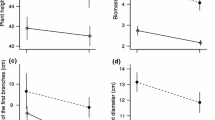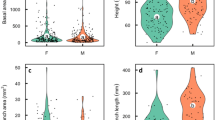Abstract
Despite being central concepts for life history theory, little is known about how reproductive effort and costs vary with individual age once plants have started to reproduce. We conducted a 5-year field study and estimated age-dependent reproductive effort for both sexes in the extraordinarily long-lived dioecious plant Borderea pyrenaica. We also evaluated costs of reproduction on vital rates for male and female plants, both by examining effects of differences in individual reproductive effort under natural conditions, and by conducting a flower removal experiment, aimed at decreasing reproductive effort. Reproductive effort was fairly constant and independent of age for males, which may reflect a strategy of adjusting overall reproductive output by spreading reproduction over the life course. Females had a higher total effort, which first increased and then decreased with age. The latter may be a response to an increasing reproductive value—an inverse of a terminal investment—or a sign of reproductive senescence due to an age-related physiological decline. Seed production was lower in plants with higher previous reproductive effort and this effect increased with age. We found no evidence for costs of reproduction on other vital rates for either sex. Experimental flower removal only resulted in progressively more negative effects on flower production in older male plants, whereas female vital rates were unaffected. Overall, this study demonstrates that not only sex, but also age influences resource allocation trade-offs and, thus, plant life history evolution.

Similar content being viewed by others
References
Aragón CF, Méndez M, Escudero A (2009) Survival costs of reproduction in a short-lived perennial plant: live hard, die young. Am J Bot 96(5):904–911. https://doi.org/10.3732/ajb.0800223
Caswell H (2001) Matrix population models, 2nd edn. Sinauer Associates, Sunderland
Clutton-Brock TH (1984) Reproductive effort and terminal investment in iteroparous animals. Am Nat 123(2):212–229. https://doi.org/10.1086/284198
Clutton-Brock TH, Isvaran K (2007) Sex differences in ageing in natural populations of vertebrates. Proc R Soc B Biol 274(1629):3097–3104. https://doi.org/10.1098/rspb.2007.1138
Dahlgren JP, Roach DA (2017) Demographic senescence in herbaceous plants. In: Shefferson R, Jones OR, Salguero-Gómez R (eds) The evolution of senescence in the tree of life. Cambridge University Press, Cambridge, pp 303–319. https://doi.org/10.1017/9781139939867.015
Descamps S, Boutin S, Berteaux D, Gaillard JM (2007) Female red squirrels fit Williams’ hypothesis of increasing reproductive effort with increasing age. J Anim Ecol 76(6):1192–1201. https://doi.org/10.1111/j.1365-2656.2007.01301.x
Ehlers BK, Olesen JM (2004) Flower production in relation to individual plant age and leaf production among different patches of Corydalis intermedia. Plant Ecol 174:71–78. https://doi.org/10.1023/B:VEGE.0000046060.77491.b9
Ehrlén J, Lehtilä K (2002) How perennial are perennial plants? Oikos 98:308–322. https://doi.org/10.1034/j.1600-0706.2002.980212.x
Ehrlén J, van Groenendael J (2001) Storage and the delayed costs of reproduction in the understorey perennial Lathyrus vernus. J Ecol 89(2):237–246. https://doi.org/10.1046/j.1365-2745.2001.00546.x
Ericsson G, Wallin K, Ball JP, Broberg M (2001) Age-related reproductive effort and senescence in free-rangin moose, Alces alces. Ecology 82(6):1613–1620. https://doi.org/10.1890/0012-9658
Galimberti F, Sanvito S, Braschi C, Boitani L (2007) The cost of success: reproductive effort in male southern elephant seals (Mirounga leonina). Behav Ecol Sociobiol 62(2):159–171. https://doi.org/10.1007/s00265-007-0450-y
García MB, Antor RJ (1995a) Age and size structure in populations of a long-lived dioecious geophyte: Borderea pyrenaica (Dioscoreaceae). Int J Plant Sci 156(2):236–243. https://doi.org/10.1086/297246
García MB, Antor RJ (1995b) Sex ratio and sexual dimorphism in the dioecious Borderea pyrenaica (Dioscoreaceae). Oecologia 101(1):59–67. https://doi.org/10.1007/BF00328901
García MB, Antor RJ, Espadaler X (1995) Ant pollination of the palaeoendemic dioecious Borderea pyrenaica (Dioscoreaceae). Plant Syst Evol 198(1–2):17–27. https://doi.org/10.1007/BF00985105
García MB, Dahlgren JP, Ehrlén J (2011) No evidence of senescence in a 300-year-old mountain herb. J Ecol 99(6):1424–1430. https://doi.org/10.1111/j.1365-2745.2011.01871.x
Hartemink N, Jongejans E, de Kroon H (2004) Flexible life history responses to flower and rosette bud removal in three perennial herbs. Oikos 105:159–167. https://doi.org/10.1111/j.0030-1299.2004.12784.x
Hiebert RD, Hamrick JL (1983) Patterns and levels of genetic variation in Great Basin Bristlecone Pine, Pinus longaeva. Evolution 37(2):302–310. https://doi.org/10.1111/j.1558-5646.1983.tb05540.x
Koenig WD, Knops JMH, Carmen WJ, Pesendorfer MB (2017) Testing the terminal investment hypothesis in California oaks. Am Nat 189(5):564–569. https://doi.org/10.1086/691161
Lacey EP (1986) Onset of reproduction in plants: size versus age-dependency. Trends Ecol Evol 1(3):72–75. https://doi.org/10.1016/0169-5347(86)90021-2
Meagher TR, Antonovics JJ (1982a) Life history variation in dioecious plant populations: a case study of Chamaelirium luteum. In: Dingle H, Hegmann JP (eds) Evolution and genetics of life histories. Springer, Berlin, pp 139–154. https://doi.org/10.1007/978-1-4684-6270-8_9
Meagher TR, Antonovics JJ (1982b) The population biology of Chamaelirium luteum, a dioecious member of the lily family. Ecology 63(6):1690–1700. https://doi.org/10.2307/1940111
Morales M, Oñate M, García MB, Munné-Bosch S (2013) Photo-oxidative stress markers reveal absence of physiological deterioration with ageing in Borderea pyrenaica, an extraordinarily long-lived herb. J Ecol 101(3):555–565. https://doi.org/10.1111/1365-2745.12080
Obeso JR (2002) The costs of reproduction in plants. New Phytol 155(139):321–348. https://doi.org/10.1046/j.1469-8137.2002.00477.x
Pianka ER, Parker WS (1975) Age-specific reproductive tactics. Am Nat 109(968):453–464. https://doi.org/10.1086/283013
Promislow DEL, Montgomerie R, Martin TE (1992) Mortality cost of sexual dimorphism in birds. Proc R Soc B Biol 250(1328):143–150. https://doi.org/10.1098/rspb.1992.0142
Roff DA (1992) The evolution of life histories. Chapman and Hall, New York
Samson DA, Werk KS (1986) Size-dependent effects in the analysis of reproductive effort in plants. Am Nat 127(5):667–680. https://doi.org/10.1086/284512
Sletvold N, Ågren J (2015) Nonlinear costs of reproduction in a long-lived plant. J Ecol 103(5):1205–1213. https://doi.org/10.1111/1365-2745.12430
Stearns SC (1992) The evolution of life histories. Oxford University Press, Oxford
Thomas H (2013) Senescence, ageing and death of the whole plant. New Phytol 197:696–711. https://doi.org/10.1111/nph.12047
Velando A, Drummond H, Torres R (2006) Senescent birds redouble reproductive effort when ill: confirmation of the terminal investment hypothesis. Proc R Soc B Biol 273(1593):1443–1448. https://doi.org/10.1098/rspb.2006.3480
Williams GC (1966) Natural selection, the costs of reproduction, and a refinement of Lack’s principle. Am Nat 100(916):687–690. https://doi.org/10.1086/282461
Acknowledgements
We are grateful to Owen Jones for comments on a previous version of the manuscript and would like to give particular thanks to the Regional Government of Aragón for permission to work with a plant of “special interest”. DAS and JPD acknowledge funding from the Max Planck Society. MBG acknowledges PERDIVER project (BBVA Foundation) and JPD acknowledges the Independent Research Fund Denmark (DFF) for funding during the analysis and writing stages.
Author information
Authors and Affiliations
Contributions
MBG and JE designed the experiments. MBG carried out the field work. All authors conceived the specific study questions. DAS and JPD conducted the statistical analyses. DAS wrote the first draft of the manuscript and all other authors contributed substantially with revisions.
Corresponding author
Ethics declarations
Conflict of interest
The authors declare that they have no conflict of interest.
Additional information
Communicated by Monica Geber.
Electronic supplementary material
Below is the link to the electronic supplementary material.
Rights and permissions
About this article
Cite this article
Sherman, D.A., Dahlgren, J.P., Ehrlén, J. et al. Sex and the cost of reproduction through the life course of an extremely long-lived herb. Oecologia 191, 369–375 (2019). https://doi.org/10.1007/s00442-019-04491-0
Received:
Accepted:
Published:
Issue Date:
DOI: https://doi.org/10.1007/s00442-019-04491-0




